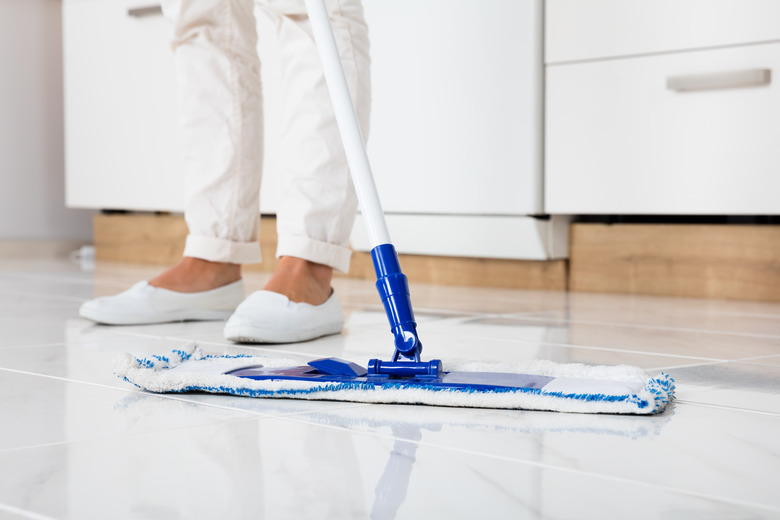What Is The Bleach To Water Ratio When Cleaning Floors?
We may receive a commission on purchases made from links.
The quantity of cleaning products available in your local store can be a little staggering, and just finding the right product for cleaning your floors can be daunting. If you equate bleach with cleaning, it might seem like it's the easiest and cheapest solution for making your dull or dirty floors sparkle. In fact, bleach should be used for the purpose of disinfecting floors rather than cleaning them. Properly diluting bleach allows it to work effectively without causing any adverse effects as you work.
Tip
Disinfect surfaces with a bleach solution using 5 tablespoons of bleach per every gallon of water, which is a ratio of around 1 part bleach to 51 parts water.
Using Bleach as a Floor Cleaner
Using Bleach as a Floor Cleaner
Bleach's value is as a disinfectant. It can kill bacteria and viruses on hard, nonporous surfaces, but it's not really a floor cleaner. It won't lift dirty footprints, dried food stains, and the other debris that accumulates on your noncarpeted floors. You might use a bleach solution as the second step in a thorough cleaning process after scrubbing the floors with a commercial floor cleaner or DIY floor cleaner, like vinegar and dish soap.
It also makes sense to use a bleach solution to disinfect floors when a person or animal with an infectious illness has been in the room. If you have little kids or pets who put toys from the floor into their mouth, you might disinfect with bleach regularly just to limit the number of germs with which they're coming in contact.
Bleach is generally safe to use on vinyl tile, ceramic tile, and linoleum. Using bleach isn't the best way to clean laminate floors, and it's not recommended that you clean hardwood floors with bleach either. These types of relatively delicate floors could be stained or corroded by bleach.
Making a Bleach Solution
Making a Bleach Solution
Bleach must always be diluted before it's used for disinfecting surfaces around the home. A diluted solution is plenty effective because it doesn't take a lot of bleach to kill germs. Watering down the bleach makes it safer to work with. Cleaning with a strong bleach solution could irritate your skin and eyes.
If you're working with regular bleach, defer to package instructions or follow the guidelines issued by the Centers for Disease Control and Prevention, which says that a safe ratio for a disinfecting bleach solution is 5 tablespoons (1/3 cup) of bleach to every gallon of room-temperature water. A gallon has 256 tablespoons, so this ratio works out to be about 1 part bleach to every 51 parts water. Always make a bleach floor cleaning solution by measuring out the water into a container and then adding the bleach.
It may be possible to disinfect floors using other bleach products. For example, OxiClean sells an oxygen bleach sanitizer that's safe for use on nonporous tile floors. Check package instructions before making any bleach solution.
Using Bleach Safely on Floors
Using Bleach Safely on Floors
Bleach loses its effectiveness pretty quickly when it's combined with water, so don't make your disinfecting solution until you're ready to use it. Clear kids and pets out of the room and create some ventilation by opening windows and/or turning on fans. After cleaning any dirt from the floors, mop with the bleach solution. Using a mop with an attached spray bottle is helpful for this project because it limits your contact with the bleach.
It takes time for bleach to kill germs, so let the floor stay wet with the bleach solution for at least a few minutes or as long as 10 minutes. Follow by mopping the floor again with plain water. Pour unused bleach solution down the drain when you're finished cleaning your floors. Once the floor is dry, it's safe for kids and pets to come back in the room.
